7 methods for heating your pool
f the water in your swimming pool is too cold, then you probably will not swim in it. If you want to enjoy your pool not only on sunny days, then you are best advised to choose an efficient pool heating system.
Without heating, the pool water will not get any warmer than 22 °C, or perhaps 25 °C on very hot days. Sports swimmers like to swim in pool water that is at least 26 °C. Most pools are even heated to 29 or 30 °C.
Moreover, pool heating allows you to extend your swimming season. Without heating, you can only swim during the summer months, from the end of May until the end of August. With heating, you can easily swim for up to 4 months longer, from April until the end of October. With some systems, you can even swim the whole year round.
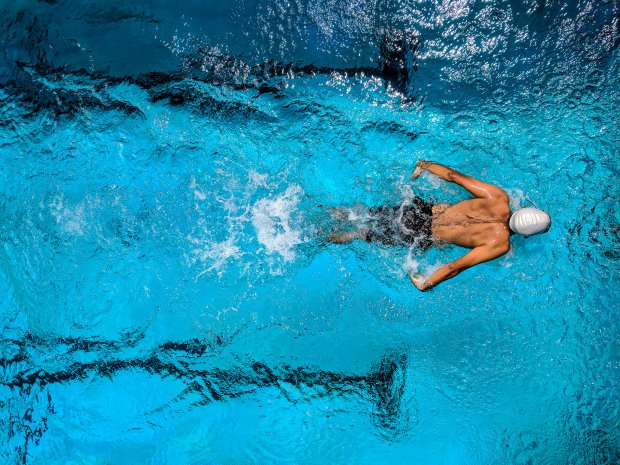
However, which type of heating or system should you choose? There is a wide choice and the ideal choice depends on numerous factors such as the type and size of the pool, the existing residential heating system, how often you wish to swim, and at which temperature and in which period you wish to swim. A number of popular pool heating systems are briefly discussed below.
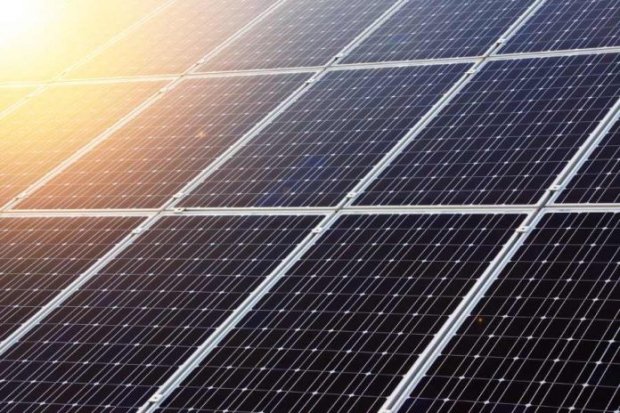
Heating your pool with solar energy
Heating your pool with sunlight appears at first to be simple and attractive. It is an energy-efficient and environmentally friendly method for heating your pool. However, within this category of pool heating systems, there are a number of options, each having its advantages and drawbacks.
Heating your pool with a solar water heater
Solar water heaters are mainly used for residential heating or for sanitary facilities. The exact application depends in part on the number of panels installed on the roof. You can also use a solar water heater to heat not only your home but your pool as well.
This is far more environmentally friendly than gas or fuel heating, but you do need energy to power the solar water heater.
A good-quality solar water heater will set you back around €5,000. However, solar water heaters are not our first recommendation for a pool heating system. They have the disadvantage of working at reduced efficiency on overcast days. It is precisely on days like these that the solar water heater has to work hard to heat up the pool or keep it warm. For a warm pool, you will therefore have to continue to rely on sunlight.
Heating your pool with solar panels
Solar panels produce energy instead of heat. This is the biggest difference from a solar boiler. The energy is totally environment-friendly and is used to heat the home and the pool with an electric heating system.
To quickly heat up your home or pool, it is best to combine solar panels with an electric heating system such as a heat exchanger.
The price of such solar panels depends on the number of panels, the type and quality of the solar panels, the capacity of the panels, and the size of the family. The larger the family, the more energy has to be generated. The purchase of solar panels will quickly set you back around €10,000.
Solar panels, too, require a large surface area, which should preferably be south facing.
Heating your pool with solar panels is perfectly possible. It is environment-friendly and the energy is completely free. You do, however, need a considerable budget and surface to install the solar panels.
Advantages
- Little to no consumption costs
- Very environmentally friendly
Disadvantages
- High purchase price
- Can only be used in summer
- Additional space needed to place the solar collectors
Solar mats or EDPM mats for heating the pool
These solar mats are commonly used to heat small swimming pools that are taken down in the winter. In a pool heating system based on EDPM or solar mats, the water is pumped through the mats. There it is heated by the sun. The sun causes the solar mats to become warm. The mats then transfer the heat to the pool water.
As indicated earlier, this solution is intended mainly for smaller pools. First of all, because a large-volume pool requires more time to pump the entire volume of water through the solar mats. As a result, it takes a very long time to completely heat up a large pool with these mats.
In addition, you need a large area to install the mats. The area of solar mats should preferably be as large as the area of the swimming pool. These heating mats are usually installed on a flat roof. This means, however, that the pump must have sufficient capacity to pump the water all the way up to the roof. If the pump is not powerful enough, the water will heat more slowly.
A serious disadvantage of these EPDM or solar mats is their weather dependence. Without sunlight, the mats will not transfer enough heat to the pool water.
The price of such mats amounts to around €50 per square metre (without installation). For an 8 m by 4 m pool, this yields a purchase cost of approximately €1,600.
Heating your swimming pool with dome-shaped solar collectors
The operation of these solar collectors is quite similar to that of solar mats. Here, however, the piping is rolled up in some kind of dome, where the water is heated up. Compared with solar mats, this system takes up far less space. One dome heats up a volume of no less than 5,000 L. For an 8 m by 4 m pool that is 1.5 m deep, you will therefore need 10 of these domes.
However, this pool heating system, too, is advisable only for comparatively small pools. It is also dependent on the sunlight and uses a great deal of energy to pump the water through the domes.
The price for one dome works out at around €100. For the same pool, it is therefore slightly cheaper than solar mats.
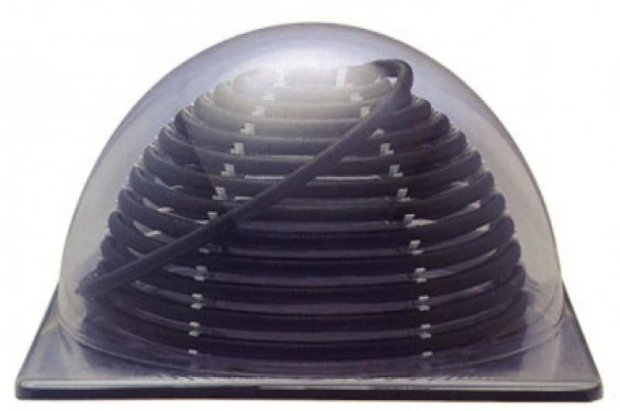
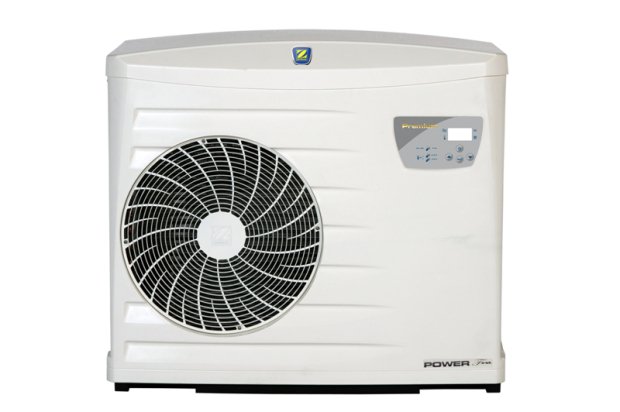
Heating your swimming pool with a heat pump
Solar energy pool heating makes you reliant on the amount of sunlight. A heat pump is therefore a perfect alternative that does not rely on the sun for energy. That is also why it has for years been the most popular pool heating system in Belgium.
Using a heat pump for heating your pool water in fact provides numerous benefits. A heat pump is highly efficient, economical, easy to use, and durable. This type of heating is much more environmentally friendly than a gas or fuel pool heating system. In addition, heat pumps have a long service life. If you want efficient pool heating, you should choose a high-quality heat pump.
Operation of a pool heat pump
A heat pump uses electricity to extract heat from the outside air and distribute it into the water. The heat pumps do not generate any heat themselves.
Heat pumps are therefore dependent on the outside temperature. Heat pumps are efficient so long as the temperature is higher than 10 °C. They generate up to 5 kW of heat for 1 kW of energy.
If the outside temperature falls below 10 °C, it is best to shut off the heat pump. That is why heat pumps are ideal for those who want to swim from April until the end of October. There are, however, specific heat pumps that can be used at lower temperatures. If you want to swim the whole year round, you can use a heat exchanger in the winter months.
Heat pumps compared with other pool heating systems
An electric pool heating system is expensive to use. It uses so much electricity that it can only be considered for whirlpools up to 1,500 L. An electric system is unsuitable for a standard pool of approx. 50,000 L.
The main drawback of gas or fuel oil heating systems is their low efficiency. These heating systems require 5 kW of energy to generate 1 kW of heat, whereas for a heat pump it is just the other way around. As a result, a great deal of energy is needed to heat a large swimming pool.
Solar systems are also quite popular pool heaters, but then you have to rely solely on the sun.
Advantages & drawbacks of pool heat pumps
The principal advantage of a pool heat pump is its high efficiency and low energy cost. Subject to normal use, the pool heating cost of a heat pump works out at 600 to 700 euros per year. This does, however, imply the use of a good-quality pool cover.
Unfortunately, heat pumps are slow heaters, so it will take a couple of days to heat the pool from around 15 °C to 28 °C. You can expect to achieve a daily gain of 2 °C.
A heat pump is also dependent on the ambient temperature. The efficiency of a heat pump increases at higher temperatures, and decreases at temperatures below 10 °C.
Pool heat pumps are often thought of as being extremely noisy, but in fact they are not. The sound level corresponds to a whispered conversation. The heat pump does not cause any noise pollution except within a 5 m radius.
Advantages
- Very efficient
- Low consumption costs
- Long service life
- Extremely quiet
- Ideal for heating larger swimming pools
- You can swim from April through October
- Environmentally sound method of heating
- Easy in use
Disadvantages
- Higher purchase price
- Dependent on the surrounding outside temperature
- Can only be used in outside temperatures above 10°C
The ideal site for installation of the heat pump
Your heat pump should preferably be installed outdoors. This eliminates the need for a service area that requires proper air supply and exhaust.
If the heat pump is installed outdoors, this is ideal to blow out the cooled air as far away as possible. This will benefit the direct ambient temperature of the heat pump and therefore improve its efficiency.
The heat pump need not necessarily be installed in the sunlight. The only parameter that matters is the ambient temperature. Around the heat pump, however, a clearance of 50 cm should be provided on each side. Along the side of the fan, a clearance of 3 to 5 m is indicated, again to allow the cooled air to escape as far as possible.
Noise is another parameter to be considered when installing the pool heating pump. While increasingly low-noise heat pumps are being manufactured, it is still preferable to reduce this noise to an absolute minimum. This can be achieved, for example, by installing the heat pump just around the corner or behind the poolhouse.
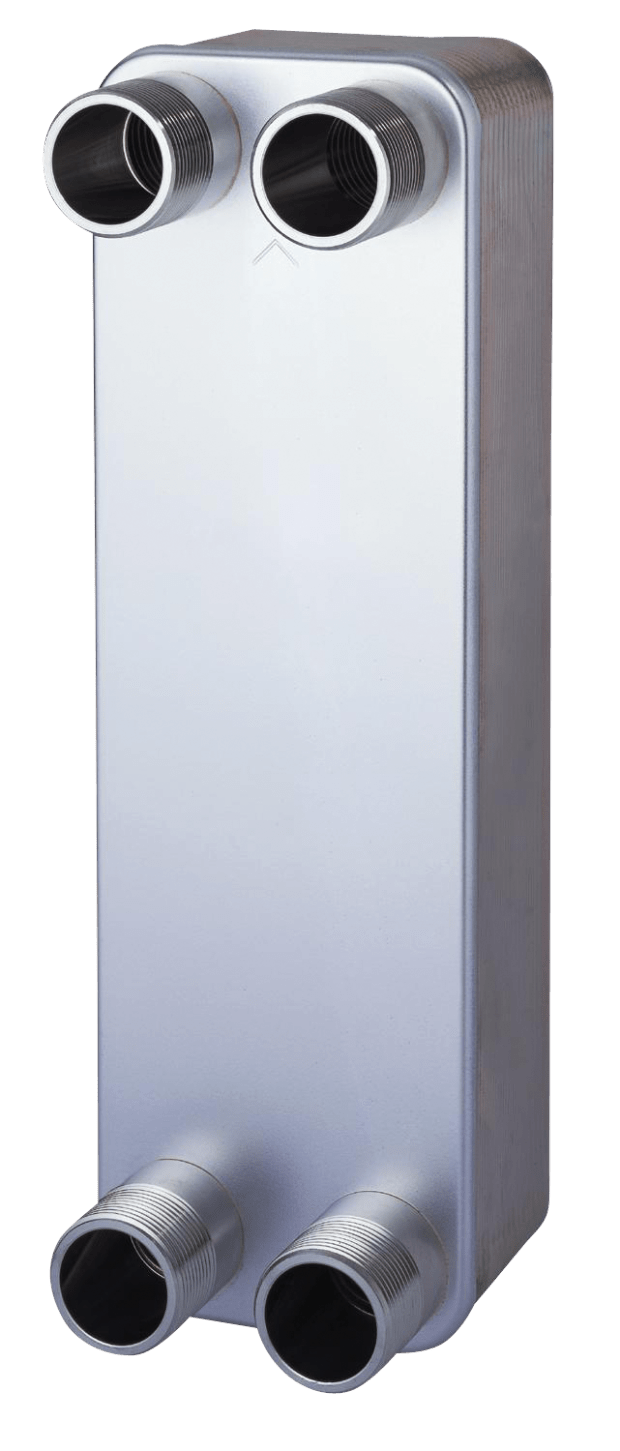
Heating your pool with a heat exchanger
To quickly heat up your swimming pool, we advise you to use a titanium heat exchanger. This is ideal for people who are not often at home to enjoy their pool. It will heat up your pool in just one day, making it ideal for a pool at a country retreat or for those who swim only sporadically.
Heat exchangers contain a corrosion-resistant heating element made from titanium. The electricity heats the resistor, which in turn transfers the heat to the water flowing past the resistance.
This titanium heat exchanger is connected to the residential heating system. This makes it a relatively inexpensive heating system to install. High energy consumption is the biggest disadvantage here. If you were constantly to use a heat exchanger to heat up your pool, it could cause a huge run-up in your costs.
Furthermore, this pool heating method is less eco-friendly than solar collectors or a heat pump pool heating system. The advantage of a heat exchanger is that it can heat up the swimming pool water even at colder temperatures and without the sun having to shine. For this reason, a heat exchanger is often combined with a heat pump or solar boiler.
With the titanium heat exchanger the water is quickly heated to a pleasant temperature. You can then let the heat pump or solar boiler take over to maintain the desired temperature without the pump having to be powered up all the time.
Advantages
- Cheaper to install
- Heats up pool water quicker
Disadvantages
- Expensive in energy consumption
- Less environmentally friendly
- Better in combination with other heating system
Heating the swimming pool with wood
You can also use a wood stove to heat your pool. In this system, the water needs to run along the stove, where it picks up the heat that is caused by the fire.
This type of heating is mainly used on smaller pools for occasional use. Heating a pool with wood is quite labour-intensive and wood is also expensive (except if you happen to own a forest).
We do not recommend this system. If you want to heat a large pool with such a system, you will constantly have to supply it with wood.
Swimming pool cover to keep the pool warm
Heating the water is important, but what is even more important is to keep the water warm for as long as possible, so that the heating system has to be used less often. That is why it is advisable to cover the pool with a tarpaulin or, better still, an automatic roller system. This will greatly reduce the cooling down of the pool water.
If you go for solar slats, the water temperature will rise automatically when the pool is not in use. This saves you a lot of energy every year!
It can pay back your investment in 2 to 3 years, reducing the energy consumption of your heating system. Using a swimming pool cover can limit the heat loss by 50%. If you decide to combine an automatic cover with solar slats, you can actually increase your pool’s water temperature by using your pool cover.
Heat Pump Glossary with the courtesy of Stephanie of Green Foot Energy Solutions
A
Air Handler: The indoor component of a heating and cooling system that circulates air throughout a building.
Air Source: A type of heat pump that extracts heat from the air and transfers it elsewhere to raise or lower the temperature of a space.
Air to Air: A variety of air source heat pump that collects heat from external air and deposits it into the air in an indoor space that needs to be heated, or collects heat from indoor air and disposes of it outside to cool an indoor space.
Air to Water: A variety of air source heat pump in which a direct action outdoor unit is combined with an indirect indoor system such as radiators. It collects heat from external air and transfers to water to provide heat through a radiant heating system.
B
British Thermal Unit (BTU): A unit of measurement that refers to the amount of heat necessary to raise the temperature of one pound of water by one degree Fahrenheit. One BTU equals roughly 1,055 joules of energy. BTU is used to measure the output of heat pumps and other HVAC systems.
C
Cubic Feet Per Minute (CFM): A unit of measurement that determines airflow volume based on how many cubic feet of air pass by a non-moving point in one minute.
Carbon Footprint: The total amount of greenhouse gas emissions created by an individual, organization, event, service, or product—such as a heating system—expressed by carbon dioxide equivalent.
Closed Loop: A type of geothermal heat pump that cycles a mixture of water and antifreeze through a closed loop of pipe buried in the ground to collect heat.
Cold-Climate Heat Pump (CCHP): Unlike conventional air-source heat pumps, a cold-climate heat pump uses an inverter, or variable speed drive, that makes it capable of efficiently heating homes in colder climates with temperatures that get down to approximately -25 degrees Celsius.
Compressor: Located in the outdoor unit of a heat pump, the compressor maintains the flow of refrigerant through the unit and compresses liquid refrigerant into a hot gas, which is then moved to the condenser coil for cooling or the evaporator coil for heating.
Condenser Coil: A component of a heat pump’s outdoor compressor unit that works in tandem with the evaporator coil inside indoor units, such as the air handler or blower compartment, to cool an indoor space. It receives refrigerant in the form of hot gas from the compressor and cools it into a warm liquid, which is then moved to the evaporator coil where it expands and cools.
Coefficient of Performance (CoP): A ratio that expresses the output of a heating unit in relation to the input of energy. It is the rated capacity of the machine divided by its rated power input, though it can be expressed as a single figure or percentage.
D
Damper: A device that opens and closes to regulate how much air flows through vents, or ducts in a ducted heat pump system.
Direct Expansion Heat Pump (DX): A type of geothermal ground-source heat pump in which refrigerant circulates through a pipe buried in the ground to collect thermal energy, unlike other closed loop systems that circulate a mixture of water and antifreeze.
Drain Pan Heater: An add-on unit that consists mainly of a heating element. It can be added to the outdoor condenser unit of a heat pump in a cold climate to warm the drain pan, so ice does not form in the drain pan or at the base of the condenser unit.
Ducted Heat Pump: Also referred to as a central heat pump or a forced air system, it connects to ductwork inside walls and ceilings and uses the ducts to move warm or cool air throughout a building.
Ductless Heat Pump: Also referred to as a mini-split, it uses air handlers connected to an outdoor compressor unit to control the temperature of individual rooms.
E
Efficiency Rating: A ratio that measures the efficiency of a heat pump. Annual heating efficiency is measured by HSPF, while annual cooling efficiency is measured by SEER.
Energy Star: A program run jointly by the U.S. Department of Energy and the U.S. Environmental Protection Agency to promote energy efficiency. The Energy Star logo is a symbol of certification for buildings and consumer products, such as appliances and heating systems, that meet certain standards of energy efficiency.
Evaporator Coil: A component of the air handler that works together with the outdoor unit’s condenser coil to complete the heat transfer cycle. When a heat pump is in cooling mode, warm air inside the room is transferred to the refrigerant in the evaporator coil to cool the air, and the refrigerant moves to the condenser coil outside to cool down. In heating mode, the heat from the refrigerant is expelled into the room to warm it up instead of moving outside.
Electronic Expansion Valve (EEV): Unlike a conventional thermostatic expansion valve that is controlled by springs, bellows, and push rods, an EEV controls the flow of refrigerant into a direct expansion evaporator based on signals it receives from an electronic controller using a thermistor.
Enhanced Vapor Injection (EVI): A technology that allows cold-climate heat pumps to improve performance in cold temperatures by allowing increased refrigerant flow into the evaporator coil.
G
Geothermal: Also referred to as ground source, water source, or earth-coupled, this is a type of heat pump system that collects thermal energy from the ground or a nearby water source and transfers it to air or water inside a building to heat an indoor space.
H
Heat Output: The amount of thermal energy a heat pump releases to warm a space, measured in BTUs.
Heat Pump: A temperature control system for buildings that transfers thermal energy from a cool space to a warm space via the refrigeration cycle. In cooling mode, it removes heat from an indoor space to make a building cooler, and in heating mode it transfers heat from outdoor sources such as air, ground, or water and moves it inside to make a building warmer.
Heating Seasonal Performance Factor (HSPF): Also referred to as Seasonal Coefficient of Performance (SCoP), this is a measurement of heating efficiency for heat pumps that is expressed by a ratio of the total thermal energy provided by the heat pump compared to the amount of electricity it uses to operate over the course of a year. HSPF differs from CoP in that it measures annual performance specifically.
Heating, Ventilation and Air Conditioning (HVAC): A broad term for the technology that provides environmental comfort inside buildings and vehicles. It can include heating, cooling, ventilation, air filtering, and humidity control.
Hybrid: Also called dual-source or multiple-source, they are varieties of heat pump systems that combine multiple geothermal sources, or both geothermal and air source.
I
Indoor Airflow: The movement of air inside in a building, calculated by cubic feet per minute (CFM).
Inverter: A component in a heat pump that controls motor speed to increase the system’s energy efficiency. A conventional furnace or air conditioning unit switches repeatedly between on or off, and the continual stopping and starting uses a significant amount of energy. Conversely, the inverter in a variable speed compressor allows for a full range of operation, similar to the accelerator in a car, and automatically adjusts output for optimal efficiency.
K
Kilowatt (kW): A measure of power equal to 1,000 Watts.
Kilowatt Hour (kWh): A unit that measures the amount of electricity used in an hour, equal to one kilowatt of power sustained for one hour, or 3,600 kilojoules.
L
Line-Set: A pair of copper tubes that connect a condenser to an evaporator so refrigerant can move between the two. The smaller tube is called a liquid or discharge line and carries the liquid refrigerant to the evaporator. The larger tube is called a suction line, and it moves refrigerant in its gaseous form back to the condenser.
Load Calculation: A calculation that determines the size of heat pump necessary to provide adequate temperature control in a given space. Load calculations involve analyzing factors such as air volume of a space and the level of insulation.
Low Ambient: Heat pumps that work well in colder climates. In the past, heat pumps were typically only effective in milder climates. However, advances in refrigeration technology have allowed manufacturers to create low ambient heat pumps that can be used in much colder climates, down to around -25 degrees Celsius. Ductless mini-split is the most common type of cold weather heat pump.
M
Mini-Split: A type of ductless heat pump system in which an outdoor compressor unit is combined with multiple air handlers inside, usually one in every high-use room.
O
Open Loop: A type of geothermal heat pump that collects thermal energy from groundwater or water from a source such as a pond, lake, or well. It pumps water from its source, circulates it through a loop of pipe, and deposits it back into the source.
Outdoor Unit: Also referred to as the compressor or condenser unit, it is the part of the heat pump system outside of the building that contains the compressor and the condenser coil.
R
Refrigerant: A fluid used in heat pumps and air conditioning systems that can change from a gas to a liquid state and back again repeatedly. There are many different types of refrigerant, which are classified in three broad categories according to how they absorb or extract heat. Refrigerants are highly regulated—and some types are banned in Canada—because of their high levels of toxicity and flammability, as well as the impact that some types of refrigerant have on the ozone layer.
Refrigeration Cycle: A reversed thermodynamic cycle in which thermal energy is transferred from a cooler space to a warmer space, the opposite of what happens naturally without intervention from a system such as a heat pump.
S
Seasonal Energy Efficiency Ratio (SEER): A measurement of the cooling efficiency of heat pumps and air conditioners expressed by the ratio of total annual cooling output of the system compared to the amount of electricity it uses in a year.
Single-Zone: Instead of one outdoor unit connected to multiple indoor air handlers, a ductless single-zone heat pump is a single compressor connected to a single air handler.
T
Thermostat: A temperature regulating device that senses the temperature in an indoor space and turns a heat pump system on or off as needed to bring the room to the desired temperature that has been programmed. Conventional thermostats must be manually adjusted to change the temperature in a room, but a smart thermostat can be programmed with a schedule that adjusts the temperature based on the time of day and week.
Thermostatic Expansion Valve (TEV or TXV): A type of metering device that is a component of heat pumps and air conditioner systems. They control how much refrigerant is released into the evaporator coil. Despite their name, thermostatic expansion valves do not regulate the temperature of the evaporator.
V
Variable Speed Drive (VSD): A heat pump with a variable speed drive uses an inverter motor to increase energy efficiency by allowing for a full range of operation, similar to a vehicle accelerator, instead of a conventional unit that is either at 0% or 100% with no operation in between those values.
W
Water Source: A type of geothermal heat pump that collects thermal energy from a water source and transfers it either to indoor air (Water to Air) or to water (Water to Water) that is used to provide warmth through a radiant heating system.
Please bookmark this glossary on your browser so you can refer to it whenever you need information about heat pump terms and definitions!